Many years ago I remember providing a presentation about outdoor play to a large group of early years practitioners. At one point a collective gasp of shock and then lots of muttering happened because I showed a photo of children playing in an icy outdoor space. The good news is that 12 years later when I showed a photo play in similar circumstances to a group of practitioners from the same part of Scotland, no-one battered an eyelid let alone questioned the rationale. So attitudes and mindsets do shift. As a group of professionals we are much more accepting of the need for children to play and experience all sorts of weather and the benefits of enabling this to happen.
The purpose of this post is to consider some of the opportunities presented by frosty weather. In Scotland we often have frost but don’t have snow. Being prepared for this phenomena is essential so that our children experience the magic and beauty of such moments. The Met Office has very good explanations of what frost is, how and when it’s likely to occur and how to forecast frost in your local area.
1. Advance preparation
This begins before children reach their nursery, school or childcare setting. Sometimes an advance warning the day before can be helpful. Some families may still assume that children will not be going outside, Providing wee tips can help develop understanding. It also means reassuring conversations can happen in advance and any additional support planned for.
- Reminders to wear lots of layers of warm clothing – thermals, woolly socks, sensible boots, winter outer layers, mittens and spare accessories. Make these visual, e.g. the Stramash Gear Guide.
- A top tip to warm outdoor gear prior to putting them on… this makes a marked difference to comfort levels.
- The need to pack a warm drink and snack
- It can take longer to walk to nursery as slippery surfaces have to be negotiated.
- Cars need to be defrosted.
At your setting, a bit of advance preparation can also go a long way:
- Do you have sufficient supplies of salt for gritting access routes into, out of and around your outdoor space? Do you know who will do this? It is particularly important to grit emergency exit points.
- Which parts of your outdoor space need gritted prior to children entering the space? Which can be done with children as part of the morning routine?
- What resources could be particularly useful the next day. For example, having tepid water can be interesting. This can be kept warm through keeping it in an insulated canister.
- Is your cloakroom warm and ready to deal with all the accessories, extra clothing and bumph of changing in and out of outdoor clothing?
- Do you have lots of spare mittens, hats, woolly socks and so on? Where should these be located so that children can access them as needed. For example, you may put holders in different parts of your outdoor space or in outdoor shelters so that it is easy to grab a pair. Some settings have loads of budget magic gloves that can be quickly washed, dried and put back out around the outdoor space.
- Where can outdoor gear be dried? Have a look at this blog post about drying and managing wet clothing. It’s important that children
- Do you have warm sheltered places for children to simply be – this is particularly important for fully outdoor settings. For other settings, it also matters – your indoor space may be the only warmth some children get.
- Are all the staff sufficiently prepared for working outside in frosty weather? Have they got appropriate clothing and footwear? How are staff roles allocated to ensure all staff get the opportunity to enjoy and participate in outdoor play? It is important that all adults model a genuine interest and enthusiasm for being outside.
- Have you amended your risk benefit assessments to ensure they reflect any planned changes to practice? For example when temperatures are very cold and well-below freezing, it can be important to remember not to touch metal objects and features with bare hands. Likewise always reinforce the message about avoiding going onto ice covered ponds or lakes or other water bodies. The Royal Lifesaving Society has this advice.
2. Noticing the frost and its impact
Listen to your children. What changes have they noticed? Give children time to talk. Be interested, excited and up for going outside. Ask children for their advice about what to wear and what we may need to remember about being outside in frosty weather.
3. Slippery surfaces
Can we always see frost on the ground and other surfaces? Sometimes, the white frost is a clue, but surfaces can become slippery without being seen. Get to know your outdoor space and which areas need gritted. Be aware of surfaces at different heights such as walls, benches and logs as well. How can we remember this and how do we learn to negotiate slippery surfaces? Most of this children will learn experientially by moving slowly or requesting support from an adult.
4. Imagining the possibilities
Frost and ice creates an ephemeral magic and beauty when it arrives. Wonder aloud with your group about how this could have happened. Invent or read stories about how the icy wonderland came to be. Jack Frost is a well-known personification of winter and he leaves his icy mark where he has been. There are several variations of the story of The Snow Queen. An online search will produce videos and stories.
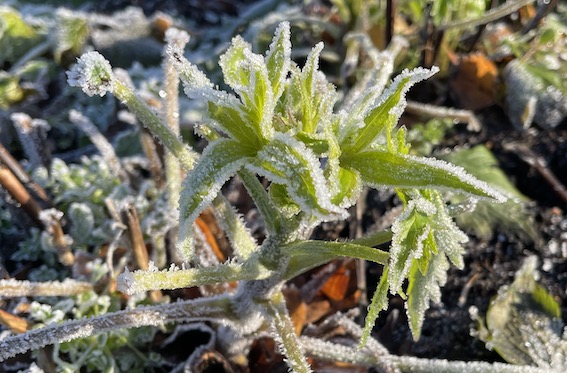
5. Look close
Use a magnifier to look closely at the ice hairs on plants and other features outside. Do they all have the same structure? Compare this with inside a freezer and the build up of ice particles. The child in the photo below was fascinated with how the sunlight made the shard he found sparkle and glitter.
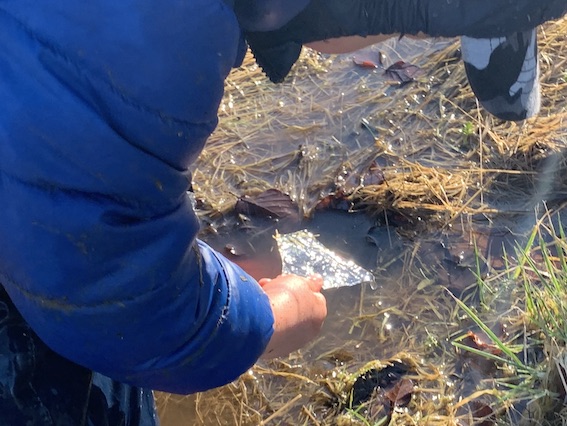
It’s also worth looking out for:
- Frosted leaves
- Spider webs
- Miniature icicles on fences
- Ground frost – on grass and tarmac
- Stones that glitter with frost
- What else do your children notice?
6. Frosty glass
Some single glass window panes can also end up with beautiful frost patterns. Talk about the term “frosted” and how it is used in relation to glass with surfaces we can’t look through. Try breathing on glass and seeing what happens on a frosty morning.
7. Exploring icy puddles
Shallow puddles provide lots of opportunity to investigate ice.
- Some children want to walk on the surface and take the risk of the ice cracking and breaking.
- Many children enjoy breaking the ice with a stick and looking closely at the shards.
- Lifting, stacking and transporting ice can appeal.
- Looking through ice is fascinating and can be surprisingly tricky.
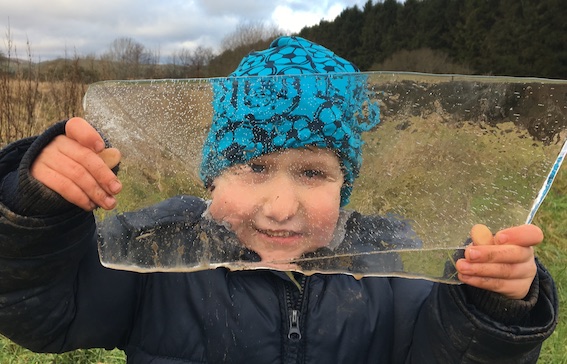
8. Does everywhere have an even covering of frost?
When the air temperatures are hovering around zero degrees celsius, it is interesting to notice where frost has appeared and where it hasn’t. For example, many woodlands can be free of frost. Sometimes the ground surrounding a tree can be frost free. Why might trees prevent frost from forming or why may it melt at the base of the tree more quickly than elsewhere?
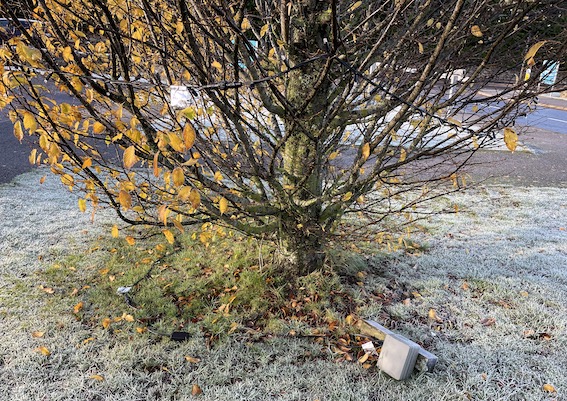
9. What happens to ice on cars?
Involve children in the actions needed to look after a car during icy conditions. This could include:
- Checking we have suitable winter tyres with sufficient tread
- Warming up the engine and giving time for the windscreens to defrost
- Scraping the ice off the side windows and mirrors.
10. Mark make on ice
Frosty surfaces can provide a place for making marks. Whilst not every car owner finds it acceptable, car windows work brilliantly for mark making. A useful alternative is a transparent tarp that is hung up outside. Use a finger or paintbrush dipped in water. Try different surfaces: wooden benches, stone walls and so on. You may be surprised to find what works well and what doesn’t.
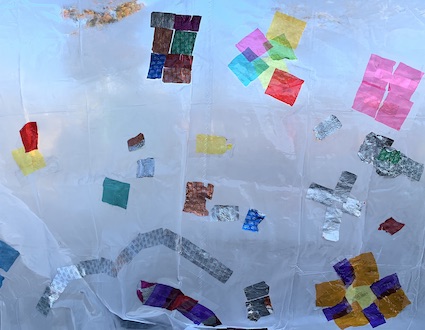
11. How are the plants and animals coping in the cold weather?
What is the local wildlife up to in frosty weather?
- It may not be easy to see animal and bird tracks but thinking about ensuring there is plenty of bird food and water that they can access can be helpful. Look at the range of berries available.
- Do any birds help themselves or do we need to have more berry-producing plants that birds like and can eat through the winter months?
- Are there any plants that will not survive frosty weather and need moved inside or to a frost-free place?
- Do wormeries need to be insulated and moved to a shed or to a frost-free place?
12. When the frost begins to melt
Encourage your group to notice when the frost is beginning to melt. What is happening to the ice – what do they see, hear and feel? Why might this be happening? See if you can find and count the drips coming from different places. If your children wanted to melt ice, what methods would they use and why. Is it possible to experiment and see if any of the suggestions work?
13. Ice art and ice cube investigations
A quick online search will reveal many different icy creations. For example:
- Frozen decorations
- Use frozen ice cubes for miniature world play. On a cold day, they will last much longer outside. Leave containers outside for frozen blocks
- Leave mirror tiles in shallow water out overnight in frosty weather. Then wait and watch the effect as they melt. What happens when you move your finger over the melting surface?
- Freeze lolly sticks and ice cubes made with natural food colouring added to the water. These can be used outside on snow, or cream coloured cloths and towels to rub and see the colour leave a mark.
- Freeze coloured water in shallow baking trays. Using fine salt in a single hole pourer, use this to create patterns on the salt. Then watch the effect. Add coloured ice cubes to create a miniature ice world.
- Use known land artists and their work as inspiration, such as Richard Shilling and his Land Art for Kids.
14. Find out and get involved in local winter sports clubs such as ice hockey and curling
Frosty weather is a great time to explore ice and winter sports. Contact your local outdoor education and sports providers to find out what activities are licensed and to signpost families to what’s available locally. Why not hold a mini curling competition with pebbles on a tuff tray that has frozen water on it?



















